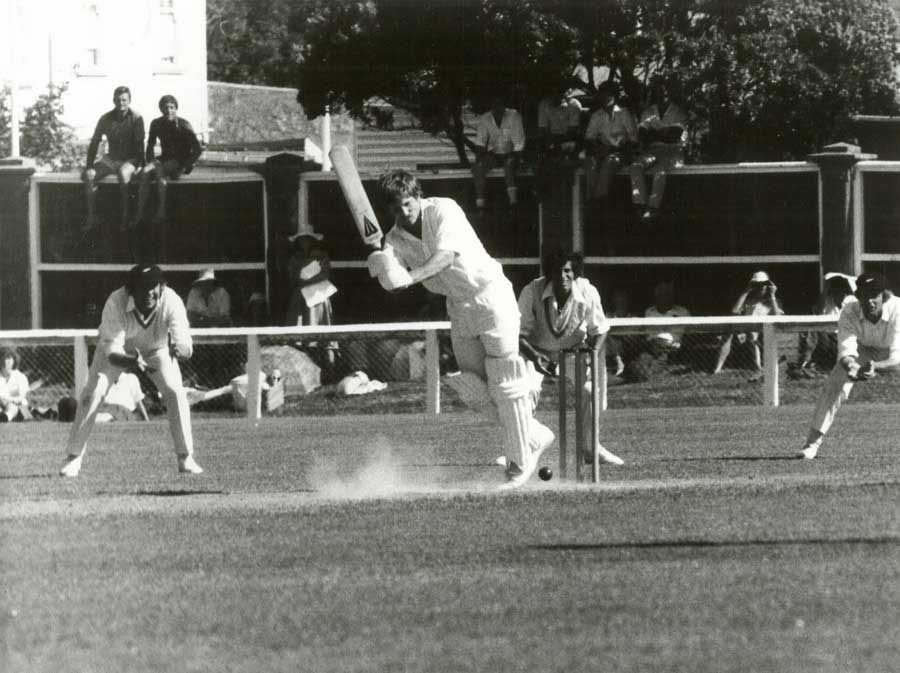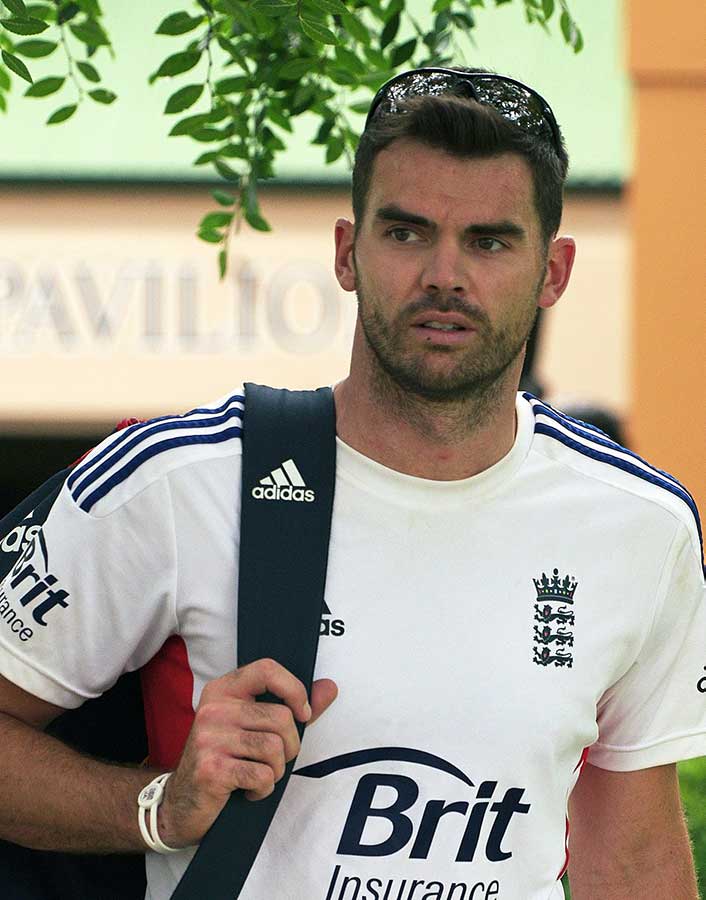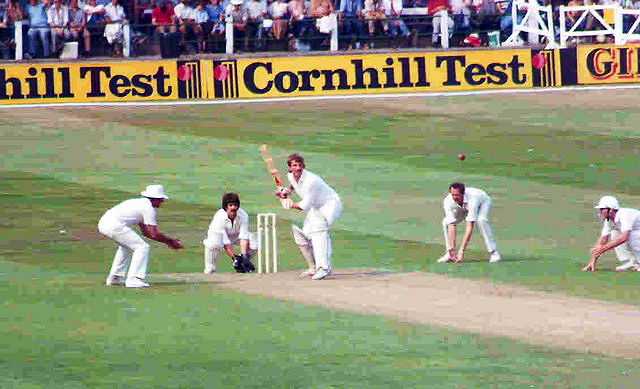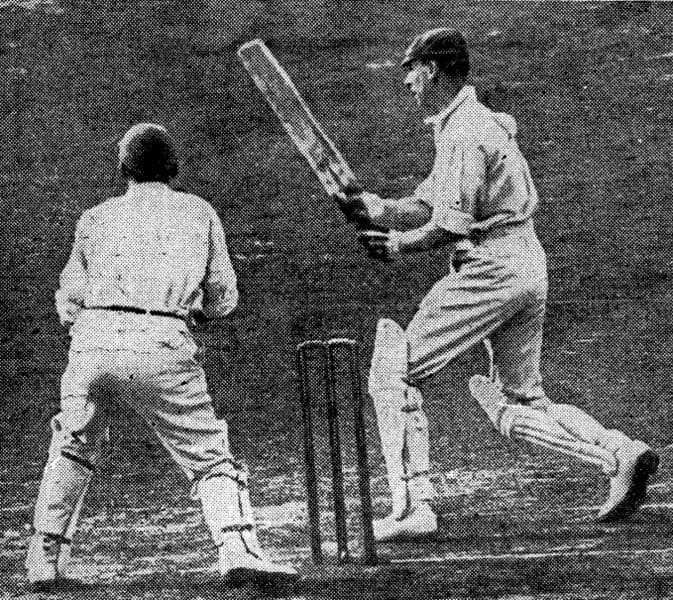1. W G Grace
Though he only played 22 test matches for England - all against Australia - WG Grace is the first name on our team sheet.
Grace scored 54,211 runs over 42 seasons in first class cricket (with 124 centuries and 251 fifties), and also took 2,809 wickets (from an extraordinary 124,833 balls). He was head and shoulders above his contemporaries. He was also a huge personality; and people were happy to pay to watch. It is no exaggeration to say that he created the modern game.

Born in 1848 in Gloucestershire, one of nine children, Grace's talent was spotted early - he scored 244 not out when playing against Surrey at the age of 18. From then on, the records kept tumbling. Grace was the first man to:
- score a century before lunch;
- score 1,000 runs and take 100 wickets in a first class season;
- score 300 runs in an innings; and
- score 2,000 runs in a first class season.
In one particularly purple patch, Grace made scores of 344, 177 and and 318 in a single week!
Grace played as an amateur, having qualified as a doctor when he was 31. Had he not prioritised his medical career over the next five years, his stats would be even better!
The reason Grace was so good was that he played every shot in the book. This was in contrast to most batsmen of the era, who were predominantly front or back foot players and who typically had one favoured shot. Indeed, Grace was one of the first players to use a full backlift, now used by all batters.
But statistics were only part of Grace's draw. His 6 foot 2 inch height, impressive beard and determination to win at virtually any cost made him a box office draw of the highest order. He would intimidate umpires, who rarely adjudged him leg before wicket; he would use technicalities in the rules, even where against the spirit of the game; and he would insist that a large proportion of match receipts be paid to him.
Interesting fact...
When bowlers appealed during a WG Grace innings, he would often reprimand them with the retort: "they came to see me bat; not you bowl!".
2. Jack Hobbs
Jack Hobbs, born John Berry Hobbs on December 16, 1882, was one of the greatest batsmen of all time.
Hobbs had a humble start to life: he was one of 12 children, and he spent most of his childhood in poverty. His father, however, was a cricket lover who was appointed groundsman at Jesus College, Cambridge in 1889.

After a slow start, Hobbs' cricketing journey began when his performances for Surrey caught the attention of selectors, and he made his debut for the England national cricket team in 1908.
At the crease, Hobbs was known for his impeccable technique, adaptability and composure. He was particularly adept at handling different types of pitches and bowlers, which earned him the nickname "The Master." Hobbs' elegant style and ability to play both defensive and attacking shots made him a formidable opponent for any bowling attack.
Hobbs' partnership with fellow English cricketer Herbert Sutcliffe became legendary, and the duo's opening stands are still celebrated as some of the best in cricket history. The two men put together a remarkable 324-run opening partnership against Australia in 1928 at The Oval.
A run machine
One of Hobbs' notable achievements was his record-breaking 199 centuries scored in first-class cricket, a record that still stands to this day.
In addition, he amassed a whopping 61,760 first class runs - another world record, which may never be broken given the rise of one-day and 20-over cricket.
Hobbs' tally of Test runs, scored over 61 tests held between 1908 and 1930, was 5,610. This included 15 centuries and 28 half-centuries. This gave him an average of 56.10, which remains one of the ten best averages for test batters who have completed more than 100 innings.
An interrupted career
Hobbs' international career was influenced by the tumultuous times of his day, especially the First World War. Despite this, he managed to maintain his high level of performance even as he advanced in age. His dedication to the game, combined with his natural talent, inspired generations of cricketers and fans alike.
Beyond his batting prowess, Hobbs also occasionally bowled medium pace and displayed versatility as an all-rounder. His cricketing intellect was evident in his captaincy of the England team on a few occasions.
He was also a very fair player. Hobbs once commented:
"People who play cricket by the rules are really the only people who matter. If you break the rules you’re only cheating yourself. You can’t cheat an opponent. That’s the way I see it."
Jack Hobbs was knighted in 1953 for services to cricket. He passed away on 21 December 1963, leaving behind an enduring legacy as arguably cricket's greatest ever batsman.
3. Walter Hammond
Walter Reginald Hammond is widely regarded as one of the greatest batsmen and all-rounders in the history of cricket.
Born on 19 June 1903, Hammond's cricketing career spanned from the 1920s to the early 1950s, leaving an indelible mark on the game with his exceptional batting and all-round skills.

Hammond was known for his stylish and elegant batting technique, which allowed him to excel in a variety of conditions and against different types of bowling. He made his debut for Gloucestershire in 1920 and soon established himself as a prolific run-scorer. His performances at the county level earned him a spot in the England national cricket team.
The bodyline series
One of the defining moments of Hammond's career came during England's tour of Australia in 1928-1929, known as the "Bodyline" series.
Despite the aggressive and controversial tactics employed by the Australian bowlers (copying English bowlers like Harold Larwood), Hammond displayed remarkable courage and skill, scoring heavily to help England secure the Ashes 4 - 1 series victory. This performance elevated his status in international cricket and solidified his reputation as a premier batsman.
Batting records
Hammond's batting records were impressive, including a then world record Test score of 336 not out against New Zealand in 1933. He was known for his ability to play both fast and spin bowling with equal proficiency, and his aggressive stroke play made him a delight to watch. He held various records for the fastest Test centuries and was known for his impeccable timing and placement of shots.
Overall, Hammond finished his test career with 7,249 runs, including 22 centuries, at an average of a whopping 58.45 (the third highest average of those who have completed 100 test innings).
Don't forget the bowling ...
In addition to his batting prowess, Hammond was also a useful medium-fast bowler and a brilliant fielder. In total, Hammond took 83 test wickets, 732 first-class wickets, and 820 first-class catches.
His all-round abilities made him a valuable asset to the team, and he often contributed with the ball and in the field. His performances earned him the captaincy of the England team in 1938.
Hammond's career was significantly affected by World War II, during which he served his country in various capacities. After the war, he made a successful return to cricket (topping the county championship averages in 1946), though his best years were arguably behind him. He retired from international cricket in 1947 but continued to play at the county level until 1951.
Legacy
Walter Hammond's impact on the game extended beyond his playing days. He held numerous records, including the highest Test aggregate runs at the time of his retirement. He was also inducted into the International Cricket Council's Hall of Fame in recognition of his contributions to the sport.
As Wisden explains:
"The judgment of cricket history is that the greatest batsmen the game has known are - in order of appearance, only - WG Grace, Jack Hobbs, Walter Hammond and Don Bradman."
Hammond passed away on July 1, 1965, leaving behind a legacy as one of the cricketing giants whose achievements continue to inspire cricketers and fans worldwide.
4. Len Hutton
Born on June 23, 1916, in Yorkshire, Len Hutton grew up to become a cricketing icon known for his impeccable technique, composure, and records that stood the test of time.

Hutton's cricketing journey began in the late 1930s when he made his debut for Yorkshire County Cricket Club. His outstanding performances at the domestic level earned him a place in the English Test squad, and in 1937, he made his Test debut against New Zealand.
Hutton's greatest performance
Hutton's defining moment arrived during the 1938-1939 Ashes series in Australia. In the fifth Test at The Oval, he scored an extraordinary 364 runs, which was then the highest individual score in Test cricket. His remarkable innings - it was only Hutton's sixth test match - played a significant role in England's victory and solidified his status as a batting maestro.
Hutton the captain
The impact of World War II disrupted Hutton's career, but normal batting service was resumed in 1946. Hutton was then appointed as England captain for a single test against India in 1952, the first 'professional' to skipper the side. He was victorious and praised for both his batting and his tactics.
Even better was to come: Hutton captained England in the Ashes on home soil in 1953. After four drawn matches, England prevailed by 8 wickets at The Oval. Hutton was the match's top scorer, and indeed topped the England averages for the series (with 443 runs at an average of 55).
Hutton's stats
Hutton's international career came to an end in 1955, but his legacy continued to inspire generations of cricketers. He scored a total of 6,971 Test runs at an average of 56.67, a testament to his consistency and excellence at the highest level. His achievements earned him a knighthood in 1956, further recognising his immense contributions to cricket.
After retiring as a player, Hutton continued to be involved in the cricketing world as a coach, commentator, and administrator. He passed away on September 6, 1990, leaving behind an unparalleled legacy that extended far beyond the boundary ropes.
Sir Len Hutton's name remains etched in the annals of cricketing history as a symbol of determination, skill, and sportsmanship.
5. Fred Truman
Born on February 6, 1931, in Stainton, England, Trueman's journey from a working-class background to becoming England's first bowler to take 300 Test wickets is a testament to his remarkable talent and determination.
Known for his fiery temperament and powerful bowling, Trueman became a cricketing legend in the 1950s and 1960s. His career spanned from 1952 to 1965, during which he played 67 Test matches for England. Right-arm fast and fearsomely quick, Trueman had an innate ability to swing the ball both ways, making him a true force to be reckoned with.

Trueman made his Test debut against India in 1952, and it didn't take long for him to make an impact. His bowling style, characterized by a long run-up and a distinctive leap at the crease, struck fear into the hearts of batsmen. Throughout his career, he amassed 307 Test wickets at an average of 21.57, cementing his reputation as one of the finest fast bowlers in cricket history.
His memorable performances include the famous Ashes series in 1956 when he took 29 wickets against the Australians. Trueman's spell of 8 for 31 against India in 1952 and his hat-trick against the West Indies in 1963 remain etched in cricketing folklore. His combative spirit and candid opinions often led to clashes with fellow players and officials, but they also added to his charismatic persona and made him a favorite among fans.
Beyond his on-field exploits, Trueman's personality shone brightly. He was known for his witty remarks and colorful anecdotes, both during his playing days and in his second career as a cricket commentator. His catchphrase "I don't know what's going off out there" became a humorous reference to his down-to-earth nature and lack of interest in off-field matters.
Trueman's contribution to cricket was recognized in 2001 when he was inducted into the International Cricket Council's Hall of Fame.
Fred Trueman passed away on July 1, 2006, at the age of 75, but his memory endures through the stories of his remarkable cricketing journey. He embodied the essence of a true fast bowler: aggressive, passionate, and relentless. His influence on the game continues to inspire fast bowlers worldwide, reminding us of the golden era of cricket when characters like Trueman made the sport unforgettable.
6. Geoffery Boycott
Born in 1940, Geoffrey Boycott opened the batting for England between 1964 and 1982.
Boycott is a stubborn man, best known for his prolific but defensive batting and incisive but cutting commentary. He has always been popular with the public - though not necessarily with the selectors or his team mates.

Yorkshire through and through
Born in Yorkshire, for whom Boycott played for 24 years, Boycott showed early promise and made his debut for the county at the age of 21. He was a loyal servant of county cricket, topping the county championship averages for six seasons, the most of any post-World War II player. Overall, he scored a massive 48,426 first class runs, with an average of 56.83, including 151 centuries and 238 half-centuries.
Boycott the test batsman
In the test arena, Boycott was also prolific. He scored 8,114 runs in his 108 test matches, at an average of 47.72 (exceptional for a test opening batsman). His runs included 22 centuries and 42 half-centuries, with a highest score of 246 not out.
But Boycott's test statistics tell only half the story. On a positive note, England did not lose any of the 22 matches in which he scored a century. Indeed in 1979 a leading commentator observed that
"any expectation of an English win, except in freak bowling conditions, is based on a major innings from Boycott."
On the negative side, Boycott was often unpopular with his teammates - who perceived him to be a selfish player, batting for his test average and not the team.
Remarkably, Boycott was dropped in 1967 after making his highest score of 246 against India. The alleged problem was that the innings took 573 minutes, and that Boycott scored at a strike rate of only 44.32 (though England won the test match comfortably).
Describing his dropping 20 years later, Boycott observed that
"I was mortified with embarrassment and filled with an angry, burning sense of injustice which I can remember clearly and painfully to this day."
Yes, No, Sorry ...
Another remarkable story arose out of the second test against New Zealand in the 1978-9 series, when Boycott was intentionally run out by Ian Botham - who was frustrated by Boycott's slow scoring when England were chasing victory (Botham once described Boycott as "totally selfish").
A third story dates from 1982, when Boycott claimed that he was too ill to field in a test match, but was later discovered playing golf.
Boycott's playing career concluded at the end of the 1986 season, when his beloved Yorkshire declined to renew his contract. His career was peppered with controversy (off the field, he was convicted by a French court of domestic abuse against his former partner), but he remained largely loved by the cricket-watching public. This was probably due to his fastidious preparation and his determination to keep his wicket intact - indeed, his mental toughness meant that he maximised every ounce of his natural talent.
Boycott the commentator
After hanging up his boots, Boycott turned himself into a respected and entertaining commentator. He coined the phrase 'corridor of uncertainty', and was not afraid to criticise players - with statements like "my mother could have caught that in her pinny" (after a fielder dropped an easy catch) and "my auntie could have hit that with a stick of rhubarb" (after a batsman missed out on an easy delivery).
Boycott was knighted by Theresa May on leaving office, though he was often referred to as Sir Geoffrey before he received official recognition.
7. Ian Botham
Born in 1955, Ian Botham is a natural sportsman, having played professional football for Yeovil Town and Scunthorpe United in addition to his cricketing career.
He is best remembered as a mercurial all-rounder, capable of turning a test match in a matter of hours, as he did at Headingley in 1981.

Botham, affectionately known as 'Beefy', made his test debut against Australia in 1977 - at the age of 21. The first four years of his test career were his most impressive, with Botham reaching the landmark of 100 wickets and 1,000 runs in 1979 faster than any previous all-rounder.
Beefy's finest hour
Botham's finest hour was undoubtedly the 1981 home series England had against Australia. He turned the Headingley test match - the third in the six-test series - on its head: following on, England were reduced to 105 for 5 (still 122 runs behind Australia) when Botham walked to the wicket; his quick-fire 149 (off 148 balls) meant that England were able to post a tricky fourth innings target for Australia of 129; they fell 18 runs short, largely due to Willis' 8 for 43.
It was only the second time that a side following on had won a test match. Botham won man of the match, as he did for the next two tests (taking 5/11 and scoring 118 respectively). With the sixth test drawn, England won the series 3 - 1.
Botham's test stats
Botham was never quite to emulate his 1981 form, but his test career finished with 5,200 runs at an average of 33.54 and 383 wickets at an average of 28.40. Indeed, Botham held the record for the most test wickets for a few years in the 1980s (taking the record from Australian Denis Lillee and having it taken from him by Kiwi Richard Hadlee).
Statistics, however, only tell part of the story. Botham was able to galvanise and inspire a team and make the other 10 players believe that they could win. In his later playing days, he turned out for Worcestershire and Durham, having played most of his career at Somerset.
In retirement, he raised about £25 million for leukaemia research, became an insightful and entertaining commentator, and was knighted and latterly assumed a place in the House of Lords.
His well-deserved title? The Right Honourable The Lord Botham OBE.
8. James Anderson
Born in Burnley in 1982, James Michael Anderson first played for England in 2002 - against Australia in Melbourne in a One Day International.
In those days, Anderson had the knack of taking wickets with unplayable deliveries, but he had not developed what was to become his legendary control of the cricket ball.

Over the years, however, Anderson has become the world's foremost exponent of seam and swing bowling. He ended up with 704 wickets in test matches, making him not only the highest English wicket taker, but the most prolific fast bowler ever.
His wicket haul is third on the all-time list, behind spinners Shane Warne and Muthiah Muralidaran (spinners typically have longer careers because their bowling actions exert less stress on the body).
Best bowling
Anderson's career best bowling figures of 7/42 were achieved in a test match at Lords in 2017, with England facing the West Indies. Aged 35 at the time, Anderson also recorded his 500th test wicket during West Indies' second innings. His scalps included Kraigg Brathwaite (bowled middle stump) and Kemar Roach (also bowled). His 7/42 was ever so slightly better than the 7/43 he achieved against New Zealand in 2008.
Anderson's longevity
Anderson's longevity - he played test cricket well into his 41st year - has much to do with his athletic build and finely tuned bowling action. He is a wonderful fielder, having taken 107 test match catches, and he holds the test batting record for the most not outs (he usually comes in at number 11!) - 114 'not outs' from 265 innings!
Anderson's partnership with his good friend Stuart Broad has made England a bowling unit to fear for over a decade.
Interesting fact...
Off the field, Anderson is known for his good looks, fashion sense and interesting haircuts, slightly surly personality, and hosting the Tailenders podcast. He posed naked for Britain's best selling gay magazine in 2010 to challenge homophobic attitudes.
Anderson was awarded an OBE for services to cricket in 2015 and will likely be knighted after he hangs up his boots. Though he played his last test match for England in July 2024, taking four wickets in England's victory over the West Indies at Lord's, he has hinted that he might continue to play in the white ball format.
9. Joe Root
Born in 1990, Joseph Edward Root has - at the age of 34 - scored over 21,500 international runs.
Best known for his sublime timing, range of shots, ability to accumulate runs and cheeky grin, Root is England's most prolific batsman - and he still has many years to come.

Root made his England debut against India in December 2012, and has been a stalwart of the test and ODI teams ever since. He passed 10,000 test runs in June 2022, the 14th player to do so and only the second Englishman.
Root is currently second on the list of test run scorers, having overtaken Ricky Ponting, Jacques Kallis, Rahul Dravid, fellow Englishman Alistair Cook and Kumar Sangakkara since 2024. Sachin Tendulkar is still 2,500 ahead of Root's tally of 13,543 runs (as of Aug 25) - so Root will need to keep on performing for another three years to become the all-time record holder.
More stats ...
Root has 39 test centuries and 66 test fifties to his name, with a highest score of 254, and a career average of a shade over 51.
In a ODI format, Root is also the most prolific Englishman, overtaking Eoin Morgan in 2025. He was a member of the English world-cup winning team in 2019, ending the tournament as England's leading run scorer. More generally, he is often the glue which holds England's innings together - letting big-hitting batsman take the limelight.
In addition, Root is a useful off-spinner (with 73 test wickets at an average of 47 and best innings figures of 5/8) and a superb slip fielder - he holds the test record for the most outfield catches (currently 213).
Finest hour
Root's best century may well have been his 134 against Australia in 2015, in the first match of an epic home Ashes series. Later that summer Root was to claim the number 1 spot in the ICC World Rankings.
Root has held the top spot on four occasions in his career, often trading it with the three other great batsman of his era: Virat Kohli of India, Kane Williamson of New Zealand and Steve Smith of Australia.
Captain Joe
Root captained England between February 2017 and April 2022, a period which included the Covid pandemic (where matches were often played without crowds and with stringent isolation rules).
On the plus side, Root holds the record for the most matches as England captain (64) and the most wins (27).
On the other hand, Root's 26 losses as captain included a 4-0 series defeat in the 2021-2 Ashes in Australia. Towards the end of his reign, Root's form with the bat suffered and he sometimes looked bereft of ideas when leading his troops in the field.
Bazball
Post-captaincy, Root has played an important role in reinvigorating the England test team under the leadership of captain Ben Stokes and coach Brendon McCullum. His test stats for 2023 were particularly impressive: 787 runs from eight matches at an average of 65 and a highest score of 153*.
Root was criticised for changing his technique too much to fit in with the Bazball ethos, particularly on England's unsuccessful tour of India in 2023/24. But the home series against West Indies and Sri Lanka in 2024 saw him return to his best form, scoring quickly and rotating the strike without trying to slog too early.
Root deserved to take England's record for the most test centuries from Alistair Cook at Lord's on 31 August 2024, with his fastest hundred to date. Root completed his 34th test century of 103 from 121 balls, selflessly sacrificing his wicket in the search for quick runs. He was the last man out.
That elusive Australian century
The Australian press, ahead of the 2025/26 home Ashes series, dubbed Root an 'Average Joe' because he hadn't made a century in (or against) Australia. After a lean first test, Root proved his detractors wrong with a fine 138 not out off 206 balls in England's first innings at the day/night second test at the Brisbane Cricket Ground. The century, his fortieth in total, means that Root has made a ton against every major test-playing nation.
Root the man
But talking about Root's achievements on the pitch only covers a fraction of the man. He has an insatiable appetite and enthusiasm for the game. He wears his talent lightly, and has none of the ego often associated with top-level sportsmen. I have heard him on stump microphones calling out opposition batsmen for making homophobic remarks. He is graceful in defeat and modest in victory. In short, he is a lovely man.
When interviewed on 31 August 2024 Root was keen to emphasise his desire to keep performing for England. He will have England's home Ashes series in 2027 in his sights. Let's hope he makes it.
10. Ben Stokes
Born on June 4, 1991, in Christchurch, New Zealand, Ben Stokes is an English cricketer who has captured the hearts of fans around the world with his remarkable talent, resilience, and inspirational leadership.

Stokes' cricketing journey began with his family's move to England when he was young. His father, Ged, who played rugby league for New Zealand, wanted to provide better opportunities for his family. This decision would shape Stokes' destiny as he embarked on a cricketing career that would see him rise to become one of England's most celebrated players.
Stokes becomes a pro
Stokes' entry into professional cricket came through Durham County Cricket Club in 2009. His raw talent, powerful batting, and bustling medium-fast bowling quickly caught the attention of cricket enthusiasts.
Interesting fact...
Stokes' debut for Durham took place at The Oval. He took the wicket of experienced internaional batsman Mark Ramprakash with his third ball!
International breakthrough
Stokes made his international debut for England in limited-overs cricket in 2011, and his Test debut followed in 2013. But his breakthrough moment on the international scene came during the 2013-2014 Ashes series in Australia. His first test century came in the third Test at Perth, with Stokes ending up with 279 runs (the third highest) and 15 wickets (the second highest).
The 2019 World Cup and Ashes series
However, it was during the 2019 ICC Cricket World Cup and the subsequent Ashes series that Stokes' star truly ascended. His incredible innings in the World Cup final against New Zealand, which included a heroic 84 not out in the final overs, played a pivotal role in England's historic World Cup victory.
Stokes' heroics continued during the Ashes series that followed. In the third Test at Headingley, he produced one of the greatest Test innings ever witnessed. His unbeaten 135, including a 76-run partnership for the last wicket, single-handedly secured an improbable victory for England, fuelling comparisons to cricketing legends.
Bazball
Stokes took over as captain of the England test team in May 2022, following a terrible run of results under Joe Root. He and new coach, Kiwi Brendan McCullum, embraced a daring fresh approach to test cricket. Dubbed 'Bazball', Stokes and McCullum give their players licence to play their natural game - and to be as aggressive as they like.
This has resulted in a rejuvenation of the England team and test cricket more generally, as other nations seek to follow suit. The remarkable results achieved using the Bazball method include:
- The 74-run win against Pakistan in Rawalpindi in 2022-23. England amassed 506/4 on Day 1, at a run rate of 6.73 per over! They won after Stokes tempted Pakistan into chasing a score on 343 in four sessions.
- England coming back from a 2-0 deficit to draw the 2023 home Ashes series 2-2. Indeed, England would have won the series if the Fourth Test at Old Trafford had not been washed out on Day 5.
- The first test against India in Hyderabad in 2024, where England overcame a first innings deficit of 190 to win by 28 runs.
That nightclub brawl
Beyond his on-field exploits, Stokes' journey has been marked by personal challenges. In 2018, he faced a trial for a brawl outside a Bristol nightclub. Stokes had gone out with teammates following an England victory over the West Indies on 24 September 2017, and got into a serious street fight. He was suspended by England and lost the vice-captaincy, but ultimately acquitted by a jury in August 2018.
Despite the controversy, Stokes emerged from the experience with a renewed focus on his cricketing career and a determination to make the most of his opportunities.
Stokes' USP
Ben Stokes' impact on cricket extends beyond statistics. He exemplifies the modern cricketer, capable of excelling in all formats of the game. His contributions with both bat and ball, his acrobatic fielding, and his leadership on and off the field have earned him respect from teammates, opponents, and fans alike.




